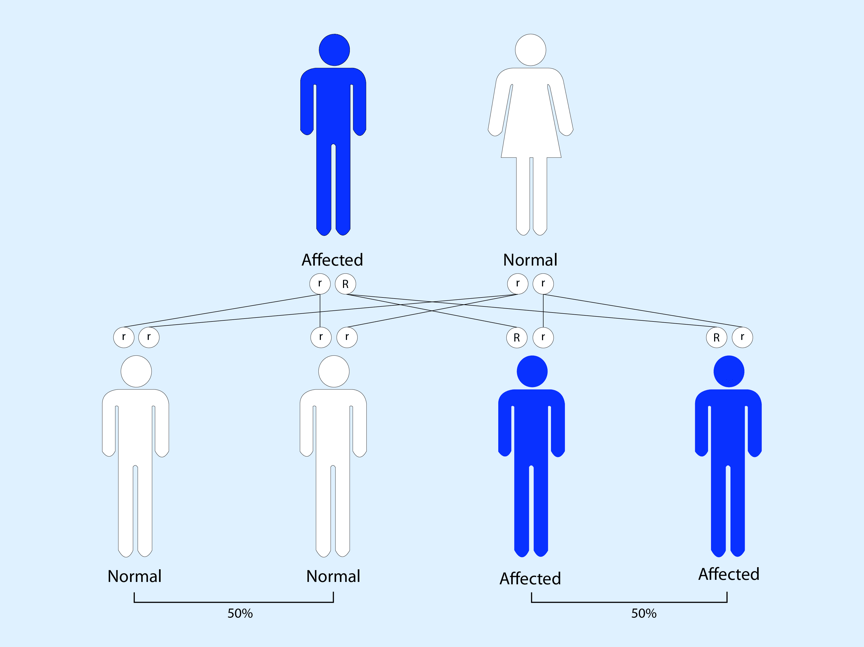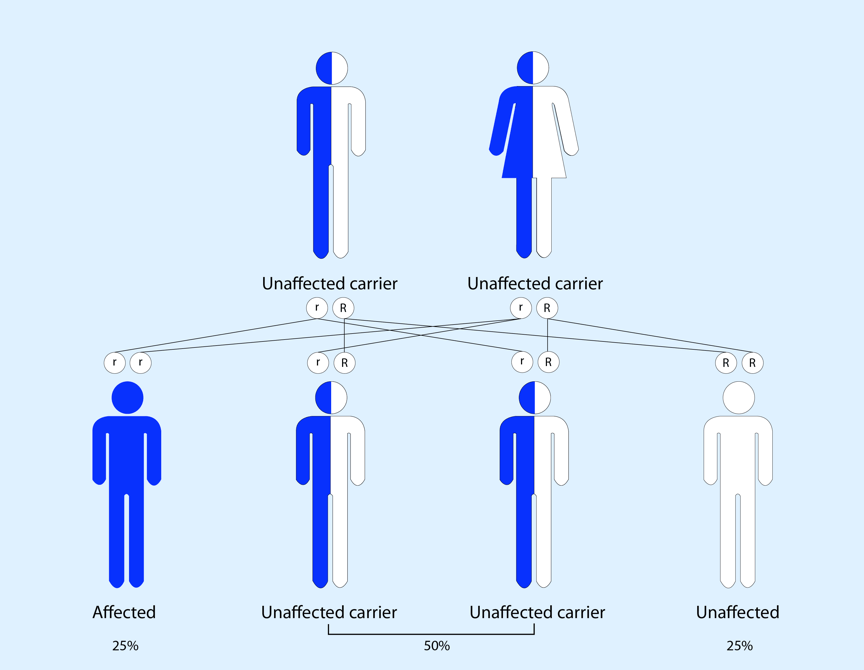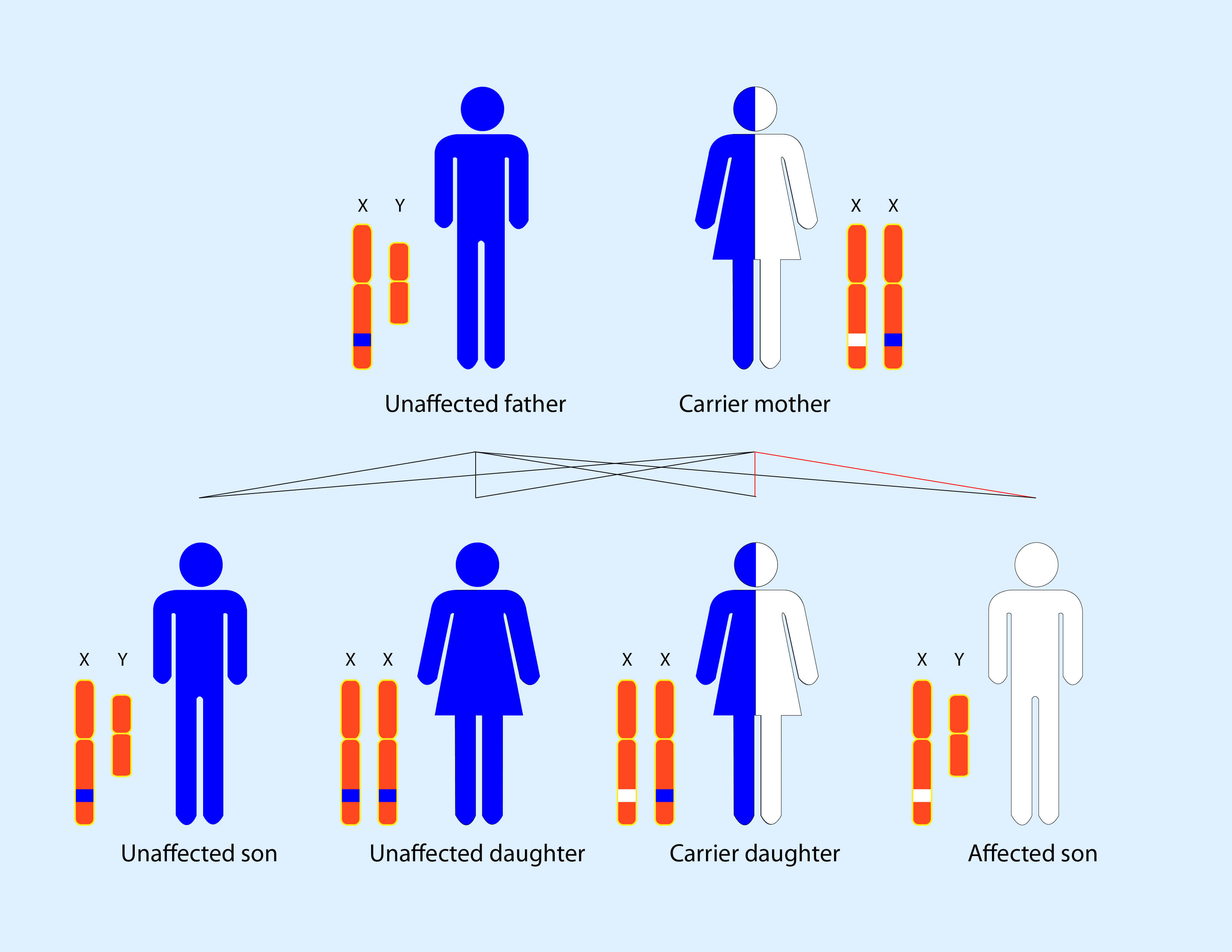A good understanding of the fundamental laws of inheritance helps us to understand the different patterns of disease transmission. The inheritance patterns of single gene diseases are referred to as ‘Mendelian inheritance’ after Gregor Mendel, the first person to observe the different patterns of gene segregation for selected traits in garden peas. From his observations, he was able to determine the probabilities of recurrence of a trait for subsequent generations.
Many genes have more than one version, caused by mutations or polymorphisms, and these are referred to as alleles. People can carry a ‘normal’ allele and/or a ‘mutated’ allele. The expression of the mutated allele with respect to the normal allele can be characterised as dominant, co-dominant, or recessive. There are five basic modes of inheritance for single-gene diseases:
- Autosomal dominant
- Autosomal recessive
- X-linked dominant
- X-linked recessive
- Mitochondrial
Autosomal dominant inheritance
Autosomal dominant inheritance is characterised by disease transmission to both heterozygous and homozygous offspring. Only a single mutated copy of the gene is necessary for a person to be affected and each affected person usually has only one affected parent.
Each child of an affected parent will have a 50% chance of inheriting the mutated gene:

The following are examples of autosomal dominant conditions:
- Achondroplasia
- Acute intermittent porphyria
- Adult polycystic kidney disease
- Ehler’s-Danlos syndrome
- Familial adenomatous polyposis coli
- Familial hypercholesterolaemia
- Huntingdon’s chorea
- Hereditary haemorrhagic telangiectasia
- Hereditary multiple exostoses
- Hereditary spherocytosis
- Hypertrophic obstructive cardiomyopathy
- Hypokalaemic periodic paralysis
- Gilbert’s syndrome
- Marfan’s syndrome
- Myotonic dystrophy
- Neurofibromatosis types 1 and 2
- Noonan’s syndrome
- Osteogenesis imperfecta
- Retinoblastoma
- Tuberous sclerosis
- Von-Hippel-Lindau syndrome
- Von Willebrand’s disease
Autosomal recessive inheritance
Autosomal recessive inheritance is characterised by the disease only being transmitted to homozygous offspring. Two copies of the abnormal mutated gene are necessary for a person to be affected. Heterozygous individuals that carry only one affected gene become carriers. They are unaffected but can pass the abnormal gene to their offspring.
Children of two unaffected carriers have a 50% chance of inheriting one abnormal gene and becoming a carrier themselves and a 25% chance of inheriting two abnormal genes and being affected by the disease:

The following are examples of autosomal recessive conditions:
- Alkaptonuria
- Ataxia telangiectasia
- Beta-thalassaemia
- Congenital adrenal hyperplasia
- Congenital erythropoietic porphyria
- Cystic fibrosis
- Dubin-Johnson syndrome
- Familial Mediterranean fever
- Fanconi anaemia
- Friedreich’s ataxia
- Galactosaemia
- Gaucher’s disease
- Glucose-6-phosphatase deficiency
- Homocystinuria
- Haemochromatosis
- Hartnup disease
- Phenylketonuria
- Sickle-cell disease
- Situs invertus
- Spinal muscular atrophy
- Tay-Sach’s disease
- Wilson’s disease
- Xeroderma pigmentosa
X-linked dominant inheritance
X-linked disorders, which are also referred to as sex-linked disorders, are caused by a mutation in the X chromosome of a sufferer.
In X-linked dominant disorders, both male and female mutation carriers are affected by a mutation on the X chromosome. Females tend to be less severely affected because of X-inactivation (also called lyonisation), which is a process by which one of the copies of the X-chromosome present in a female is inactivated. These disorders are frequently much more severe, or even lethal, in males, because they only have a single X-chromosome.
All offspring of an affected female have a 50% chance of being affected. If the condition is lethal in males (e.g. incontinentia pigmenti), a skewed birth ratio may be observed resulting in a higher proportion of live females with the condition.
The following are examples of X-linked dominant conditions:
- Charcot-Marie-Tooth disease (type X)
- Fragile X syndrome
- Hypophosphataemic vitamin D resistant rickets
- Rett’s syndrome
- Incontinentia pigmenti
- Periventricular nodular heterotopia
X-linked recessive inheritance
In X-linked recessive disorders, only males are affected. Heterozygous females are clinically unaffected but are carriers of the affected gene.
The following family pedigree chart shows the transmission of the affected mutated gene in white:

The following are examples of X-linked recessive conditions:
- Alport’s syndrome
- Becker muscular dystrophy
- Duchenne muscular dystrophy
- Fabry’s disease
- Glucose-6-phosphate dehydrogenase deficiency
- Haemophilia A and B
- Hunter’s syndrome
- Lesch-Nyhan syndrome
- Red-green colour blindness
- Testicular feminisation syndrome
- Wiskott-Aldrich syndrome
Mitochondrial inheritance
Mitochondria are exclusively maternally inherited as they are derived from the mitochondria present in the cytoplasm of the ovum. Mutations in mitochondrial DNA can result in biochemical problems due to the absence or impairment of enzymes involved in the respiratory chain and reduced supply of ATP.
Within cells, there can be a mixed proportion of normal and abnormal mitochondria, which is referred to as heteroplasmy. Different proportions of abnormal mitochondria may be required to cause disease, and this is referred to as the threshold effect.
The following are examples of mitochondrial conditions:
- MELAS (mitochondrial encephalopathy, lactic acidosis, stroke-like episodes)
- MERRF (myoclonic epilepsy, ragged red fibres)
- Mitochondrially inherited diabetes mellitus and deafness
- Leber’s hereditary optic neuropathy
Thank you to the joint editorial team of www.plabprep.co.uk for this ‘Exam Tips’ post.
Images used on license from Shutterstock






